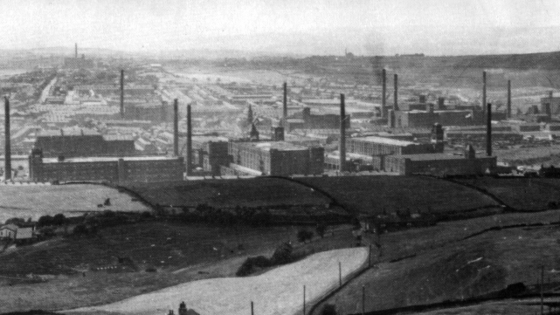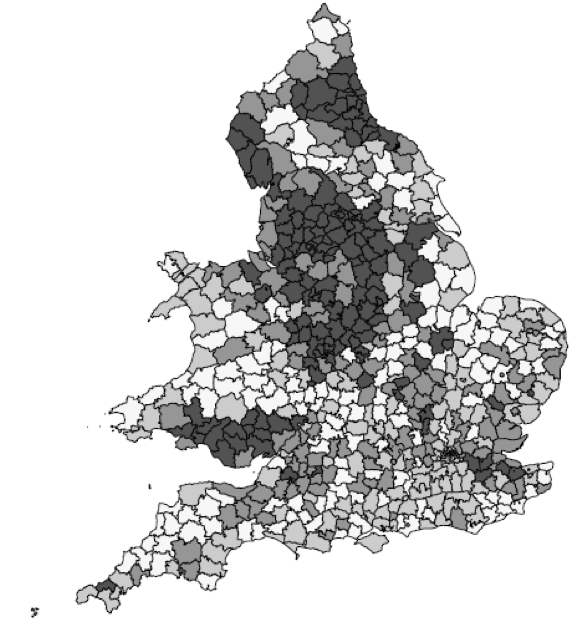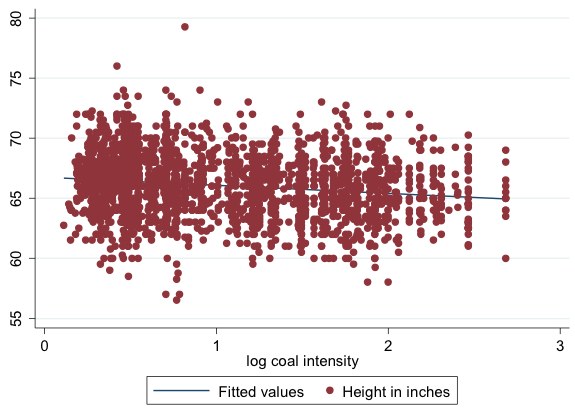There is growing concern over the effects of atmospheric pollution on health. In 2016 WHO reported that 92% of the world’s population lives in in places where air pollution exceeds WHO limits (WHO 2016). It is calculated that outdoor air pollution accounts for three million deaths per year. And most of these deaths occur in low- and middle-income countries. The dense smog in China’s cities provides a sharp contrast to the relatively clean air of cities in the West.
But it was a different story a century ago. Coal-fired industrialisation in Europe spawned factories that belched black smoke, with little government regulation. Black smoke from these emissions was in the order of 50 times higher than today. Partly for this reason, urban centres had much higher mortality rates than rural areas. Indeed, there is evidence that the mortality gradient by industrial emissions was steeper in 19th century Britain than it is in China today (Hanlon and Tian 2015).
The more modest levels of atmospheric pollution in recent times, as reflected by concentrations of particulate matter and other pollutants, have been linked to premature death and to a variety of illnesses (Currie et al. 2013). Children are especially vulnerable as their lungs are still developing and they are prone to repeated infection. But while there is no shortage of stories of the evil effects of the dark satanic mills of the past on the wellbeing of those who lived nearby, the quantitative evidence is thin.
In the 19th century dense smoke from factory chimneys left a signature in the form of an indelible black coating on the walls of cathedrals and town halls. But the effects on health are more difficult to measure. In a recent study, Beach and Hanlon (2016) assessed the effect of industrial coal combustion on mortality rates in 19th century Britain. To do so, they constructed a measure of industrial coal-use based on the occupational composition of different localities. This index is strongly correlated with local death rates, especially among those under five, and it accounts for one third of the urban mortality penalty.
In a recent paper, we use a similar approach to estimate the effects of smoke pollution on the health of those that survived (Bailey et al. 2016). Our outcome measure is the adult heights of children in who were born in the 1890s. Height is an indicator of health conditions during childhood, and it depends both on the level of nutrition and on the disease environment. These in turn are infuenced by socioeconomic conditions in the household and in the locality.
We obtain heights for a sample of 2,235 men who enlisted in the British army around the time of WWI. Their average height is five feet six inches (167.6cm) and their average age on enlistment is 20.3 years. We find these men as children in the 1901 census of England and Wales, so we are able to observe their household circumstances and, most importantly, the locality in which they were growing up.
In order to measure exposure to atmospheric pollution, we combine information on coal consumption by industry from the 1907 census of industry with the occupational structure of employment from the 1901 population census. This gives us a measure of industrial coal intensity for each of the 635 registration districts of England and Wales. Figure 1 shows the map of coal intensity (by quartiles), where darker areas represent higher coal intensity. This closely reflects the geography of 19th century industrialisation.
Figure 1. Map of coal intensity in England and Wales in 1901
How does coal intensity relate to adult height? Figure 2 shows a downward-sloping relationship between (log) coal intensity and height. But there are many other influences at work, including genetic variation. We use regression analysis to control for household characteristics, including the social class of the head of the household and the number of siblings in the family. We also control for local population density, which has a strong negative effect on height. In the presence of these controls we find a significant negative relationship between coal intensity and adult height. This predicts a difference of nearly an inch (2cm) between the least and the most coal-intensive locations (10th vs 90th percentiles).
Figure 2. Scatterplot of height and log coal intensity
As our measure of air pollution is indirect, it is possible that an effect on health and height could potentially arise though channels other than the atmosphere. So we look for additional evidence. One piece of evidence derives from the fact that the winds that carry atmospheric pollution are predominantly south-westerly. We would expect that coal intensity in districts to the southwest would affect height. This is exactly what we find. Coal intensity in districts to the southwest has a significantly negative effect on height while coal intensity in districts to the northwest does not.
It is possible that we are simply picking up heterogeneity among households that were engaged in different industries. If the effect of coal intensity on height is to be interpreted as reflecting atmospheric pollution, then it should not be affected by the occupation of the head of household. We find that the coal intensity of the household head’s occupation has no effect on the adult heights of children. So the effect of local coal intensity is not simply a composition effect but a genuine locality effect.
There was considerable inter-district mobility in 19th century Britain, which could obscure the true locality effects. If for some reason, housholds with smaller children were more likely to migrate into coal-intensive districts, then the effect of coal intensity on adult height could simply reflect the selectivity of migration into districts with heavy industry. But we find little evidence of such selectivity. Indeed, in-migrants seem to have somewhat healthier children.
In order to identify the channels through which atmospheric pollution affected adult height during childhood, we turn to the mortality statistics. Respiratory diseases accounted for over 20% of all deaths of those aged under five. Death rates from respiratory causes varied widely between districts and they are strongly correlated with the death rates from all causes. Looking across districts, we find that our measure of coal intensity has a strong positive effect on the respiratory death rate.
If we interpret the respiratory death rate as a proxy for the local disease environment, then we can use this as an indicator of the channel though which atmospheric pollution affected adult height. We find that height is negatively correlated with local child death rates, and especially with the respiratory death rate. Using coal intensity as an instrumental variable, we find evidence that atmospheric pollution affected adult height through the channel of respiratory disease. So the effect that we observe seems to work through the relevant epidemiological mechanism.
In the past century atmospheric pollution has fallen to a small fraction of its 19th century level. Industrial coal use has dramatically declined and clean air acts have become effective. If this improvement was of the same order of magnitude as the difference between the most and the least polluted areas in the 19th century then it would have contributed nearly an inch (or 2 centimetres) to the long run increase in average height. From the birth cohorts of the 1890s to the those of the 1980s the heights of British men have increased by 2.75 inches (7cm) (Hatton and Bray 2010). So the decline in atmospheric pollution may have contributed significantly to improved health over the long run.
References
Bailey, R E, T J Hatton, and K Inwood (2016), “Atmospheric Pollution and Child Health in Late Nineteenth Century Britain”, CEPR Discussion Paper 11702.
Beach, B, and W W Hanlon (2016), “Coal Smoke and Mortality in an Early Industrial Economy,” University of California, Los Angeles, unpublished paper.
Currie, J, J S Graff Zivin, J Mullins and M J Neidell (2013), “What do we Know about Short and Long Term Effects of Early Life Exposure to Pollution?”, NBER Working Paper 19571.
Hanlon W W, and Y Tian (2015), “Killer Cities Past and Present,” American Economic Review (Papers & Proceedings), 105, 570–575.
Hatton, T J, and B E Bray (2010), “Long Run Trends in the Heights of European Men, 19th–20th centuries,” Economics and Human Biology, 8, 405-413.
World Health Organisation (2016), Ambient Air Pollution: A Global Assessment of Exposure and Burden of Disease, Geneva: WHO.




